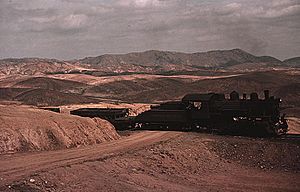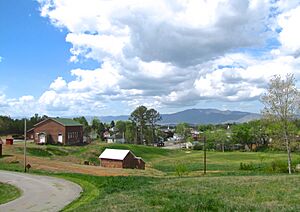Ducktown, Tennessee facts for kids
Quick facts for kids
Ducktown, Tennessee
|
|
|---|---|

Buildings along Main Street in Ducktown
|
|

Location of Ducktown in Polk County, Tennessee.
|
|
| Country | United States |
| State | Tennessee |
| County | Polk |
| Established | 1840s |
| Incorporated | 1951 |
| Named for | Cherokee village at the site prior to settlement |
| Area | |
| • Total | 2.64 sq mi (6.84 km2) |
| • Land | 2.64 sq mi (6.84 km2) |
| • Water | 0.00 sq mi (0.00 km2) |
| Elevation | 1,732 ft (528 m) |
| Population
(2020)
|
|
| • Total | 461 |
| • Density | 174.56/sq mi (67.39/km2) |
| Time zone | UTC-5 (Eastern (EST)) |
| • Summer (DST) | UTC-4 (EDT) |
| ZIP code |
37326
|
| Area code(s) | 423 |
| FIPS code | 47-21740 |
| GNIS feature ID | 1283051 |
Ducktown is a small city in Polk County, Tennessee, United States. Its name in the Cherokee language is Gawonvyi. About 461 people lived there in 2020. Ducktown is part of the larger Cleveland area.
Contents
History of Ducktown
Ducktown is in a special area called the Copper Basin. This place was a major center for copper mining for many years. Mining started in 1847 and continued until 1987. Besides copper, miners also found iron, sulfur, and zinc.
Cherokee People in the Copper Basin
The Cherokee people lived in the Copper Basin long before European settlers arrived. Their land reached into northern Georgia. A Cherokee village called Gawonvyi was located where the Ocoee River and Tumbling Creek meet. Gawonvyi means "duck place" in English. This village was first called "Ducktown" in 1799. People say it was named after a Cherokee leader known as Chief Duck.
In 1836, the Cherokee gave up control of the Copper Basin to the U.S. government. This was part of a deal called the Treaty of New Echota. Many Cherokee people were forced to leave their homes. Some hid in the mountains nearby. They later helped build the Old Copper Road. This road is now part of U.S. Route 64. In the 1840s and 1850s, Ducktown was sometimes called Hiwassee. This name came from a major river in the area.
Early Days of Copper Mining

Copper was first found in Ducktown in 1843. A prospector, who was likely looking for gold, discovered pieces of native copper. The first copper ore was carried out by mules in 1847. Between 1852 and 1855, over 30 companies started mining copper in Ducktown. A road was built in 1853 to connect the area to Cleveland, Tennessee. This helped speed up mining. The first smelter, a place to melt ore, was built in 1854.
Mining stopped in 1863 when Union troops destroyed the copper refinery and mill in Cleveland. It started again in 1866. But by 1878, the easy-to-reach copper was gone.
Later Mining Years
By 1906, the Tennessee Copper Company began building a special plant. This plant would turn most of the sulfur from the mining process into sulfuric acid. This stopped the sulfur from going into the air. In the 1920s, a new method called Froth flotation was added. This helped separate the copper even better.
Geography and Location
Ducktown is in the middle of the Copper Basin. This is a wide valley in the southern Appalachian Mountains. It is close to where Tennessee, Georgia, and North Carolina meet. The Ducktown area is part of the Ocoee River system. The Ocoee River hosted the canoe slalom events for the 1996 Summer Olympics in Atlanta.
Ducktown is located just north of where Tennessee State Route 68 and U.S. Route 64 cross. Route 68 connects Ducktown to Madisonville to the north and Copperhill to the south. Route 64 connects it to Cleveland to the west and Murphy, North Carolina to the east.
The city covers about 1.9 square miles (4.9 square kilometers) of land.
The Ducktown Basin Museum is in Ducktown. It is located at the old Burra Burra Mine site. The museum teaches visitors about the history of mining in the area.
Population and People
| Historical population | |||
|---|---|---|---|
| Census | Pop. | %± | |
| 1890 | 221 | — | |
| 1960 | 741 | — | |
| 1970 | 562 | −24.2% | |
| 1980 | 583 | 3.7% | |
| 1990 | 421 | −27.8% | |
| 2000 | 427 | 1.4% | |
| 2010 | 475 | 11.2% | |
| 2020 | 461 | −2.9% | |
| Sources: | |||
Population in 2020
| Race | Number | Percentage |
|---|---|---|
| White (non-Hispanic) | 423 | 91.76% |
| Native American | 7 | 1.52% |
| Asian | 8 | 1.74% |
| Other/Mixed | 23 | 4.99% |
In 2020, there were 461 people living in Ducktown. There were 174 households and 120 families.
Population in 2010
In 2010, Ducktown had 475 people. There were 209 households. Most people were White (96.21%). A small number were Black or Native American.
About 16.3% of households had children under 18. Many households (46.4%) were individuals living alone. About 27.8% of people living alone were 65 or older. The average household had 2.04 people. The average family had 2.92 people.
The median age in Ducktown was 49 years old. This means half the people were younger than 49, and half were older. About 25.9% of the population lived below the poverty line. This included 30.4% of those under 18.
See also
 In Spanish: Ducktown (Tennessee) para niños
In Spanish: Ducktown (Tennessee) para niños


